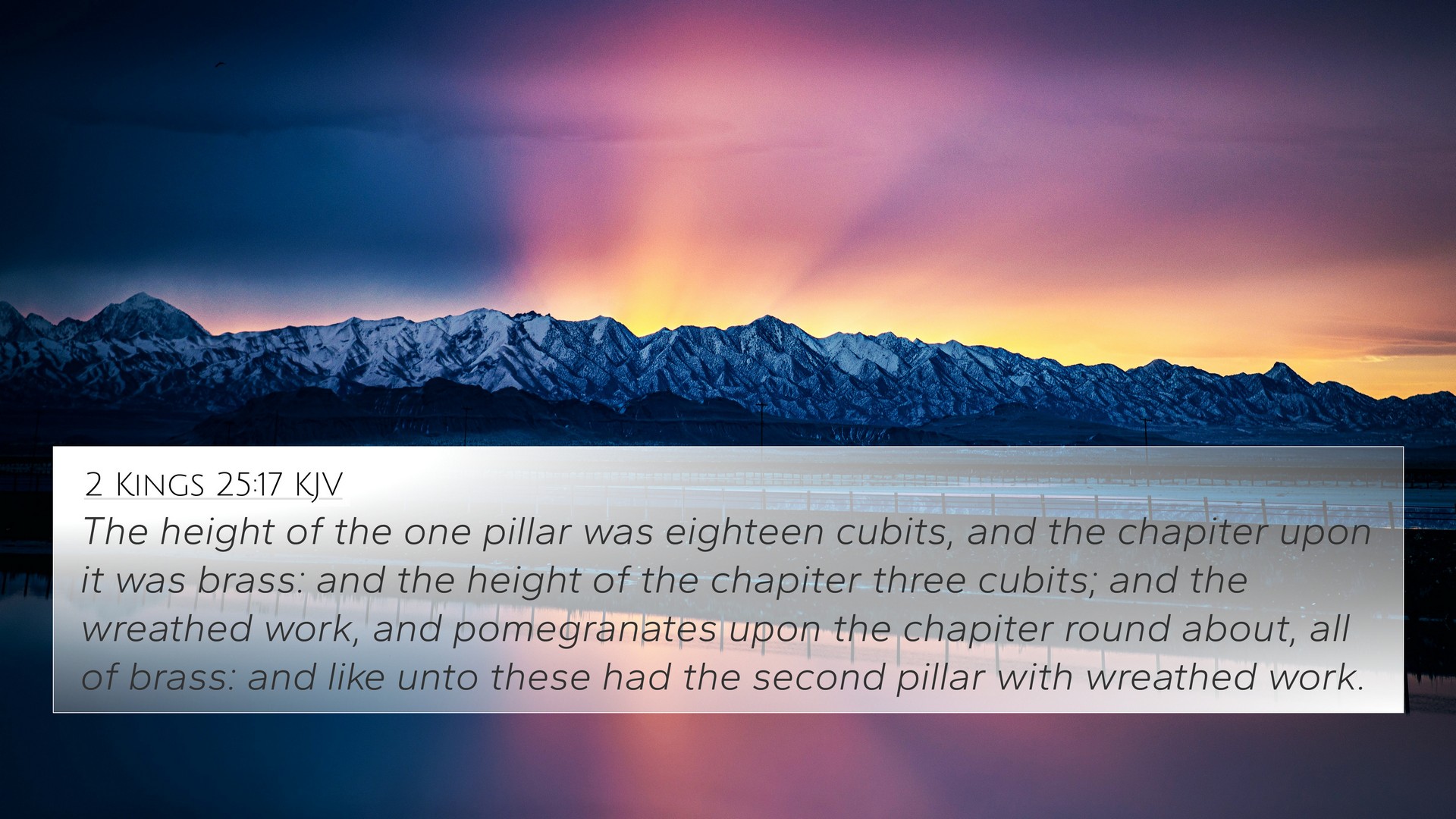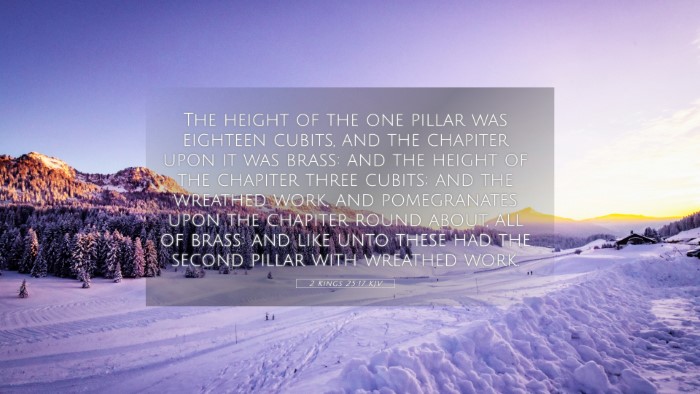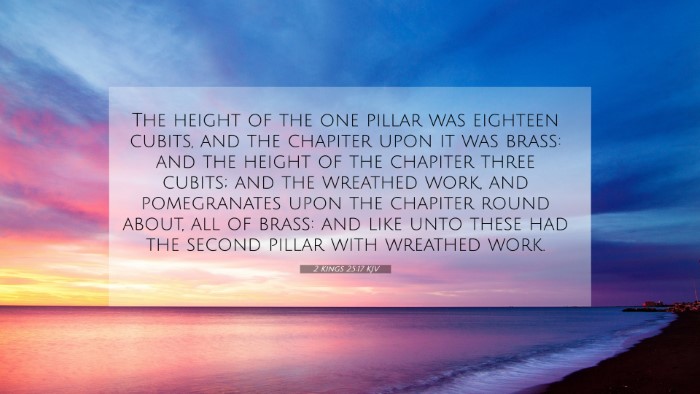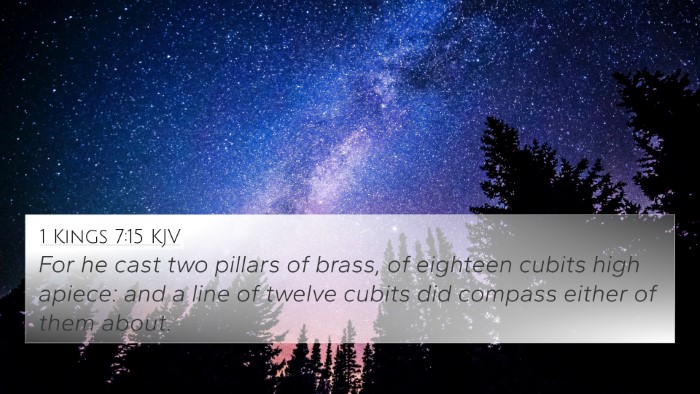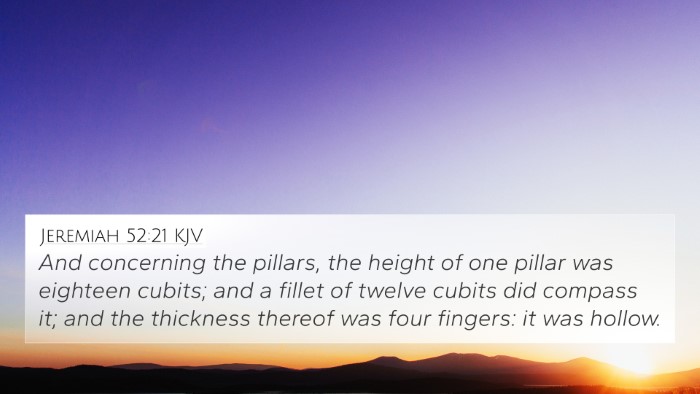Understanding 2 Kings 25:17
Bible Verse: 2 Kings 25:17
“The height of the one pillar was eighteen cubits, and the chapiter upon it was brass: and the height of the chapiter three cubits; and the wreaths of chain-work, and pomegranates upon the chapiter round about, all of brass. And like unto these had the second pillar with wreaths.”
Summary of Meaning
This verse provides a detailed description of the pillars of the temple, specifically focusing on their height and the ornamental details that adorned them. It serves as both a historical record and a representation of the grandeur of Solomon's temple, which was known for its architectural splendor and symbolized God's presence among His people.
Insights from Public Domain Commentaries
-
Matthew Henry:
Henry emphasizes the meticulous design and craftsmanship of the temple pillars. He suggests that their height and embellishments reflect the glory of God and the significance of the temple as a central place of worship. The description of the brass and the artistic details serves to highlight the wealth and artistry involved in constructing places dedicated to God.
-
Albert Barnes:
Barnes notes the implications of the brass chapiters, which can be seen as symbols of strength and durability. He links these physical features to the spiritual realities of God's everlasting kingdom. This verse elucidates the importance of the temple as not merely a physical structure but as a representation of God's covenant with His people.
-
Adam Clarke:
Clarke focuses on the artistic elements mentioned in the verse, commenting on the symbolism of the pomegranates and chain-work. He interprets these details as elements that portray fertility, abundance, and the interwoven nature of God’s relationship with His faithful. The verse may also signify the unity of the people in their worship and devotion to God.
Bible Cross References
In understanding 2 Kings 25:17, several other verses provide additional context and thematic connections:
- 1 Kings 7:15-22 - Details the construction of the temple pillars and their descriptions.
- 2 Chronicles 3:15-17 - Discusses the pillars in Solomon's temple, linking the details with their spiritual significance.
- Jeremiah 52:21 - Mirrors the descriptions of the temple's pillars, emphasizing their height and construction materials.
- Isaiah 60:13 - Indicates future restoration and the rebuilding of Jerusalem, invoking imagery of strength and beauty.
- Hebrews 9:24 - Connects the physical temple to the heavenly sanctuary, offering a spiritual parallel.
- Revelation 21:10-11 - Describes the New Jerusalem with grandeur, akin to that of the temple’s architectural beauty.
- Psalms 48:1-2 - Celebrates Zion as a place of beauty and divine presence, reflecting the themes of the temple.
Thematic Connections
The detailed description of the pillars in 2 Kings 25:17 connects to broader biblical themes, including:
- The Majesty of God: The grandeur of the temple mirrors the majesty of God’s presence on earth.
- The Covenant Presence: The temple serves as a reminder of God’s covenant with Israel and His desire to dwell among His people.
- Spiritual Strength: The enduring materials used (brass) symbolize strength in faith and God’s eternal nature.
- Art and Worship: The artistic descriptions invite believers to consider the creativity in worship and devotion.
- Restoration and Hope: Cross-references point to future restoration, conveying hope for the people of Israel.
Connecting Themes in the Bible
This verse encourages the exploration of various methods to perform Bible cross-referencing. Exploring relationships between Old Testament and New Testament verses can enrich understanding:
- Investigate the connections between Bible verses related to the architectural significance of temples.
- Utilize a Bible concordance to find thematic verse connections linking the temple and personal worship.
- Conduct comparative Bible verse analysis on sanctuaries and their representations across biblical texts.
- Incorporate a Bible cross-reference guide to enhance sermon preparation and theological teaching.
Conclusion
2 Kings 25:17, while a verse focused on architectural details, opens a window into deeper spiritual truths and historical significance. By utilizing tools for Bible cross-referencing, readers can engage in a more profound study of Scripture, appreciating the links and connections among verses. This kind of study reveals the richness of God’s word and invites believers into a deeper relationship with Him as they explore the meanings behind the text.
